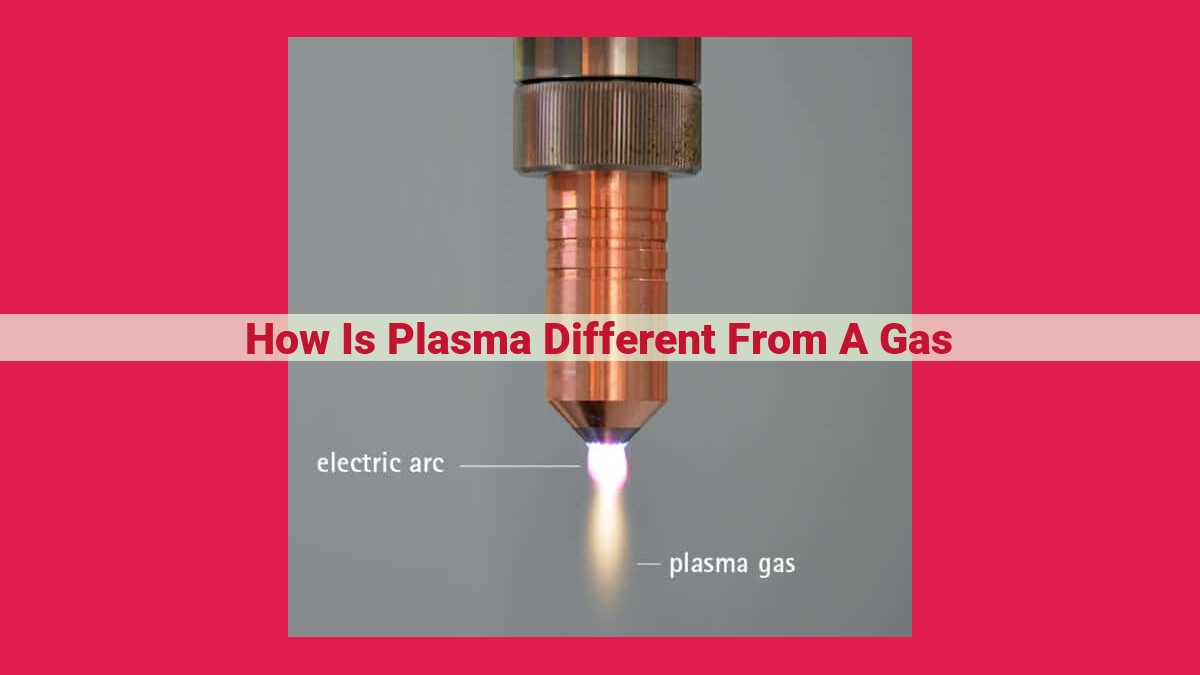Plasma: An Ionized Gas With Unique Properties For Advanced Applications

Plasma, an ionized gas, is distinct from a neutral gas due to its high ionization rate, resulting in free ions and electrons. Its elevated temperatures enhance ionization, giving plasma unique properties such as excellent electrical conductivity. Magnetic confinement techniques allow control of plasma’s inherent volatility, while quasineutrality maintains overall electrical balance. Collective behavior among charged particles leads to plasma waves and oscillations, and Debye shielding influences electrostatic interactions. Additionally, turbulence, a chaotic motion, can impact stability and confinement.
Ionization: The Defining Difference
In the realm of matter, a plasma stands out as a unique and captivating substance. It’s the fourth state of matter, alongside solid, liquid, and gas. But what sets plasma apart is the way it behaves.
Unlike a neutral gas, where atoms mind their own business, a plasma is an ionized gas. Imagine a gas where the electrons have been liberated from their atoms, leaving behind positively charged ions. This sea of free electrons and ions gives plasma its extraordinary properties.
The process of ionization is the key to understanding plasma. It occurs when neutral gas atoms are subjected to intense heat or electromagnetic radiation. This energy strips electrons from their atoms, creating a soup of free charges. These free electrons are responsible for plasma’s unique characteristics, such as its high electrical conductivity and ability to be manipulated by magnetic fields.
High Temperature: The Fiery Heart of Plasma
Plasma, the dynamic fourth state of matter, sets itself apart from ordinary gases by its fiery nature. Unlike gases, plasma is characterized by its high temperature, which plays a pivotal role in shaping its unique properties.
Temperature and Ionization: An Inseparable Duo
Temperature is a crucial factor in unlocking the transformative power of plasma. As the temperature of a gas rises, the atoms and molecules gain kinetic energy, causing their electrons to become more agitated. When this kinetic energy reaches a critical threshold, the electrons break free from their atomic orbits, leaving behind positively charged ions. This process, known as ionization, is fundamental to the creation of plasma.
Impact of Temperature on Plasma Properties
The elevated temperature of plasma not only triggers ionization but also exerts significant effects on its overall behavior. Higher temperatures intensify the ionization process, increasing the number of free ions and electrons present in the plasma. This heightened ionization, in turn, leads to enhanced electrical conductivity, a defining characteristic of plasma.
Moreover, temperature influences plasma viscosity and thermal conductivity. As the temperature rises, plasma particles move faster and collide more frequently, increasing viscosity and impeding the flow of heat. This temperature dependence of plasma properties is crucial in applications such as nuclear fusion, where controlling temperature is paramount for achieving stable and efficient reactions.
Electrical Conductivity: Plasma’s Electric Lifeline
Plasma’s Unmatched Conductivity
When matter transforms into plasma, it undergoes a profound change. The once-neutral gas atoms are stripped of their electrons, creating a sea of free charges. This abundance of independent electrons empowers plasma with unrivaled electrical conductivity.
Contrasting with Gases
Unlike ordinary gases, where electrons are tightly bound to their atoms, plasma electrons are highly mobile and can move freely under the influence of electric fields. This striking difference makes plasma an exceptionally good conductor of electricity.
Applications Galore
Plasma’s exceptional conductivity has a wide range of applications:
- Plasma displays use plasma’s ability to emit light to create vibrant and colorful screens.
- Plasma torches harness plasma’s heat and conductivity to cut and weld materials with precision.
- Plasma thrusters propel spacecraft by ejecting plasma, making them efficient for deep space exploration.
Significance for Applications
Plasma’s high electrical conductivity is not only a defining characteristic but also has practical implications. It enables plasmas to respond quickly to electric fields, making them ideal for fast-switching devices and high-power electronics.
In summary, plasma’s exceptional electrical conductivity stems from its abundance of free electrons. This unique property makes plasma a promising material for a multitude of cutting-edge technologies and applications.
Magnetic Confinement: Taming the Untamed Plasma
In the realm of ionized matter, plasma, a state of gas characterized by free-roaming electrons and ions, holds the key to unlocking the secrets of nuclear fusion. However, confining this elusive substance presents a significant challenge. Enter: magnetic confinement, a technique that harnesses the power of magnetic fields to tame the untamed plasma.
The Principle of Magnetic Confinement
Magnetic confinement works on the principle that charged particles, such as ions and electrons, experience a force when they move through a magnetic field. This force, known as the Lorentz force, causes the particles to follow curved paths. By carefully arranging magnetic fields around a plasma, physicists can control the motion of the particles and prevent them from escaping.
Applications in Nuclear Fusion
Magnetic confinement is crucial in the pursuit of nuclear fusion, the process of combining atomic nuclei to release vast amounts of energy. To achieve fusion, plasma must be confined for a long enough time and at a high enough temperature to allow the nuclei to interact and fuse. Magnetic confinement provides the necessary conditions by isolating the plasma from the surrounding environment and preventing its premature escape.
Tokamaks and Stellarators
Two prominent magnetic confinement devices are tokamaks and stellarators. Tokamaks use toroidal (donut-shaped) magnetic fields, while stellarators employ helical (twisted) magnetic fields. Both designs aim to create a stable plasma configuration that minimizes energy loss and allows for sustained fusion reactions.
Challenges and Future Prospects
Magnetic confinement is a complex technology that faces several challenges. Maintaining the necessary magnetic fields requires powerful superconducting magnets, which can be both expensive and challenging to operate. Additionally, plasma instabilities can disrupt confinement and lead to energy loss.
Despite these challenges, magnetic confinement remains a promising approach for harnessing the power of nuclear fusion. Ongoing research and development efforts are focused on improving the stability and efficiency of confinement devices, paving the way for a future where clean and limitless energy from fusion becomes a reality.
Quasineutrality: A Balancing Act of the Plasma Realm
In the enigmatic world of plasma, a paradoxical dance unfolds. Plasma, an ionized gas, harbors a sea of free ions and electrons, yet it maintains an overall electrical neutrality. This delicate balancing act, known as quasineutrality, governs the behavior of this extraordinary state of matter.
Imagine a grand ballroom filled with an exuberant crowd of electrons and ions. Each particle sways and whirls with its own unique charge, creating a chaotic symphony of positive and negative forces. Amidst this maelstrom, a remarkable equilibrium emerges. The positive charges of ions cancel out the negative charges of electrons, leaving the plasma as a whole electrically neutral.
This delicate balance is not a coincidence but rather a fundamental property of plasma. The free electrons in plasma are highly mobile, constantly colliding with ions and neutralizing their charges. This incessant dance creates a dynamic equilibrium, ensuring that the plasma remains quasineutral.
Quasineutrality exerts a profound impact on plasma behavior. It limits the electric fields that can exist within the plasma, as any buildup of charge is quickly neutralized by the mobile electrons. This phenomenon is crucial for understanding plasma dynamics, as it significantly affects plasma stability and confinement.
In conclusion, quasineutrality is the enigmatic balancing act that governs the behavior of plasma. It ensures that, despite the presence of free charges, plasma maintains an overall electrical neutrality. This fundamental property underpins the unique characteristics and applications of this fascinating state of matter.
Collective Behavior: A Symphony of Charged Particles
- Explain the strong interactions between electrons and ions in plasma.
- Describe plasma waves and oscillations as examples of collective behavior.
Collective Behavior: A Symphony of Charged Particles
In the enigmatic realm of plasma, where ionization reigns supreme, the charged particles embark on a harmonious dance. Electrons, like nimble ballet dancers, float through the plasma, while ions, their heavier counterparts, move with a stately grace.
Their interactions weave a complex tapestry, a symphony of charged particles. These interactions give rise to fascinating phenomena known as plasma waves. These waves are not like those that ripple across the ocean’s surface; instead, they undulate through the plasma itself, carrying energy and information like cosmic messengers.
Plasma waves can manifest in a multitude of forms, each with its unique characteristics. Some resemble gentle ripples, while others surge like tumultuous tides. These waves are not merely passive observers; they actively influence their surroundings. They can scatter light, accelerate charged particles, and even trigger instabilities, shaping the plasma’s behavior like maestros conduct an orchestra.
Another striking manifestation of collective behavior in plasmas is plasma oscillations. These oscillations occur when the plasma is disturbed from its delicate equilibrium. Like a pendulum swinging back and forth, the charged particles oscillate in unison, restoring the plasma to its harmonious state.
The collective behavior of charged particles in plasma is a captivating aspect of this extraordinary state of matter. It not only underscores the interconnectedness of the microscopic world but also has far-reaching implications for plasma applications, such as fusion energy and plasma processing. By understanding and harnessing the symphony of charged particles, scientists can unlock the transformative potential of plasma and enrich our technological horizons.
Debye Shielding: A Protective Barrier in Plasma
In the realm of plasma, a unique and enigmatic state of matter, electrostatic forces play a crucial role in shaping its behavior. However, there exists a phenomenon that acts as a barrier, limiting the extent of these interactions: Debye Shielding.
Imagine a plasma as a vibrant dance of charged particles, electrons, and ions, jostling and interacting with each other. Each particle carries an electrostatic charge, creating invisible forces that influence their movements. In a typical gas, these forces extend over vast distances, allowing particles to interact across large gaps.
However, in the intense heat of plasma, a remarkable transformation occurs. The high-energy particles collide with such vigor that they knock electrons free from their atoms, creating a sea of free electrons that permeate the plasma. This ionization process gives plasma its unique properties, including an exceptionally high electrical conductivity.
Amidst this chaotic ballet of charged particles, Debye Shielding emerges as a regulating force. It arises due to the screening effect of the free electrons. As a positively charged ion attracts electrons, a cloud of electrons forms around it, creating a region of negative charge. This negative cloud effectively cancels out the ion’s attraction beyond a certain distance, known as the Debye length.
The Debye length is a crucial parameter that governs the behavior of plasma. It determines the distance over which electrostatic forces can effectively interact. Beyond this length, the screening effect of the free electrons weakens, and the interactions between charged particles diminish.
The impact of Debye shielding on plasma dynamics is profound. It limits the range of electrostatic forces, thereby reducing the influence of individual particles on each other. This effect stabilizes the plasma, preventing the formation of large-scale charge separations that could lead to disruptive instabilities.
Debye shielding also plays a vital role in plasma confinement. In many applications, magnetic fields are employed to confine plasma within a controlled space. However, the charged particles in plasma can interact with these magnetic fields, potentially causing the plasma to escape. Debye shielding acts as a protective barrier, minimizing the interaction between particles and magnetic fields, ensuring the stability and confinement of the plasma.
In conclusion, Debye shielding is an essential phenomenon that influences the behavior of plasma. By limiting the range of electrostatic interactions, it stabilizes plasma, prevents disruptive instabilities, and plays a crucial role in plasma confinement. Understanding Debye shielding is key to unlocking the full potential of plasma in various scientific and technological applications.
Turbulence: A Chaotic Dance in the Plasma Realm
In the vast tapestry of plasma’s captivating properties, one stands out as a mesmerizing enigma: turbulence. This chaotic motion, fueled by instabilities and external forces, transforms plasma into a swirling vortex of charged particles.
plasma’s dynamic nature gives rise to a myriad of instabilities that can trigger turbulence. These instabilities can stem from variations in density, temperature, or velocity within the plasma, creating regions of unequilibrium. The interaction between these unstable regions leads to the formation of eddies, whirls, and filaments that dance through the plasma.
The role of turbulence in plasma dynamics is profound. It can enhance or diminish plasma confinement, the delicate balance of forces that keep the plasma from escaping its magnetic cage. In some cases, turbulence can promote mixing and transport, facilitating the exchange of particles and energy within the plasma. However, excessive turbulence can also lead to instability and disruption, jeopardizing the stability of plasma devices.
The effects of turbulence extend beyond confinement. It can alter plasma’s electrical conductivity and radiative properties, affecting its ability to conduct electricity and emit light. Turbulence also plays a crucial role in the formation of plasma jets, filaments, and other fascinating structures observed in astrophysical phenomena.
Understanding plasma turbulence is a formidable challenge that requires a multifaceted approach. Researchers employ sophisticated numerical simulations, experimental diagnostics, and theoretical models to unravel the intricacies of this chaotic dance. By deciphering the language of turbulence, scientists hope to harness its power for advancements in fusion energy, astrophysics, and other plasma-related applications.





